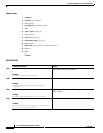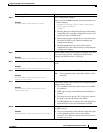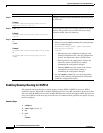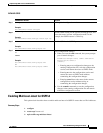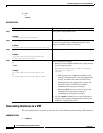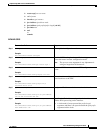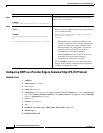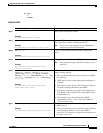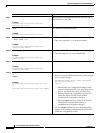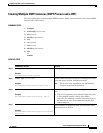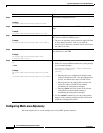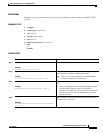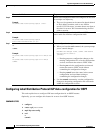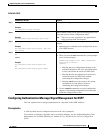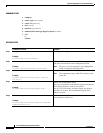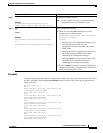
Implementing OSPF on Cisco IOS XR Software
How to Implement OSPF on Cisco IOS XR Software
RC-242
Cisco IOS XR Routing Configuration Guide
OL-14356-01
Step 7
interface type instance
Example:
RP/0/RP0/CPU0:router(config-ospf-vrf)#
interface POS 0/0/0/0
Enters interface configuration mode and associates one or
more interfaces to the VRF.
Step 8
exit
Example:
RP/0/RP0/CPU0:router(config-if)# exit
Exits interface configuration mode.
Step 9
domain-id [secondary] type {0005 | 0105 | 0205
| 8005} value value
Example:
RP/0/RP0/CPU0:router(config-ospf-vrf)#
domain-id 0105 1AF234
Specifies the OSPF VRF domain ID.
• The value argument is a six-octet hex number.
Step 10
domain-tag tag
Example:
RP/0/RP0/CPU0:router(config-0spf-vrf)#
domain-tag 234
Specifies the OSPF VRF domain tag.
• The valid range for tag is 0 to 4294967295.
Step 11
disable-dn-bit-check
Example:
RP/0/RP0/CPU0:router(config-ospf-vrf)#
disable-dn-bit-check
Specifies that down bits should be ignored.
Step 12
end
or
commit
Example:
RP/0/RP0/CPU0:router(config-ospf-vrf)# end
or
RP/0/RP0/CPU0:router(config-ospf-vrf)# commit
Saves configuration changes.
• When you issue the end command, the system prompts
you to commit changes:
Uncommitted changes found, commit them before
exiting(yes/no/cancel)?
[cancel]:
–
Entering yes saves configuration changes to the
running configuration file, exits the configuration
session, and returns the router to EXEC mode.
–
Entering no exits the configuration session and
returns the router to EXEC mode without
committing the configuration changes.
–
Entering cancel leaves the router in the current
configuration session without exiting or
committing the configuration changes.
• Use the commit command to save the configuration
changes to the running configuration file and remain
within the configuration session.
Command or Action Purpose



